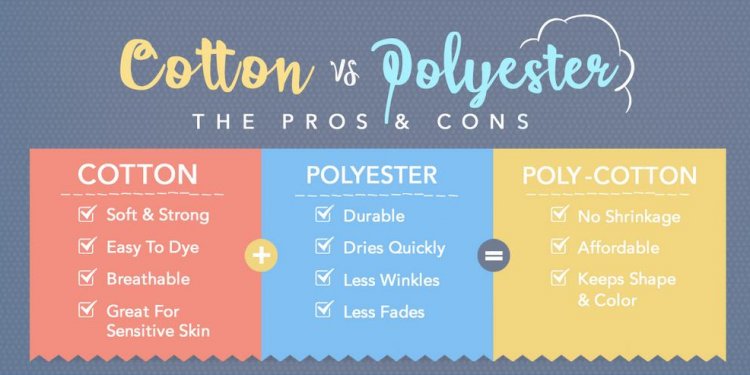
Absorbency of polyester
Not sure if you should buy a cotton or polyester shirt? Or perhaps a cotton/polyester blend? Although polyester has only been around for roughly half a century, it's use for fabric-based products continues to grow. On the other hand, cotton's popularity shows no signs of waning away anytime soon. Here's how these two wonder fabrics compare.
Cotton
Cotton fabric is highly regarded for its versatility and natural comfort. Harvested from the cotton plant, this soft, fluffy material is used for apparel, bedding, thread, tarpaulins, towels, and many other products. The cultivation and use of cotton dates back to prehistoric times.
Cotton has a softer, more supple feel than polyester and is less likely to irritate the skin. Cotton is also breathable which further contributes to its comfort. For those with sensitive skin, including infants, cotton is the better choice. When it comes to towels, washcloths, underwear, sheets, and pillowcases, cotton is king.
Polyester
Polyester is a petroleum-based synthetic fiber that was created in the 1940's by British and American chemists. In 1951, it was marketed by du Pont under the name Dacron. Today, polyester is used in the manufacture of many products including clothing, recording tapes, electrical insulation, carpeting, drapes, and miscellaneous other home furnishings.
Polyester and other synthetic fibers enable the creation of materials with superior water, wind and environmental resistance compared to cotton and other plant-derived fibers. When's the last time you saw a raincoat made from cotton?
Shrinkage, Durability, Wrinkling
Polyester is generally more durable than cotton and less prone to fading, shrinking and wrinkling. However, it is more subject to runs and pulls. For certain occupations, such as a restaurant worker, the durability of polyester is a clear advantage for clothing that is washed frequently and subjected to harsh detergents. Note that heavier weight cotton fabrics such as jeans are quite durable and can last a long time.
Poly/cotton blended products combine the softness of cotton with the durability of polyester. They tend to keep their shape and color, are not prone to wrinkling, and shrink very little, even when washed with warm or hot water. The cotton component also makes them more comfortable than products made solely of polyester. Blended products generally cost less and last longer than 100% cotton.
Other Properties
Polyester is less absorbent than cotton and hence it dries faster. Some polyester garments are designed to be moisture wicking, an attribute that is extremely useful for athletic pursuits and cold weather activities such as hunting.
Polyester's low absorbency also makes it more stain resistant than cotton. Furthermore, polyester does not require hot water when washed. This translates to energy savings over the lifetime of a polyester garment relative to a cotton garment.
Environmental Impact
Ecologically speaking, both cotton and polyester have their drawbacks, although polyester, which is made from petroleum, may have a slight edge. Cotton is the most pesticide-dependent crop in the world, using as many as one-fourth of all pesticides made. It is also a very water intensive crop. Both fabrics involve copious amounts of water, energy, and toxic chemicals during the manufacturing process.
Unlike polyester, cotton is biodegradable so old, discarded clothing will eventually break down into natural compounds. Cotton is also a renewable and sustainable resource, although there are environmental issues associated with the way it is commonly grown.
Fire Hazard
Cotton is more combustible than polyester. It ignites easily and burns rapidly, leaving behind a light ash residue. Polyester resists ignition but once ignited, it melts and causes severe localized burns. The fire hazard is also high with cotton/polyester blends due to the high rate of burning and fabric melting. The safest route is to purchase clothes that are treated with fire retardant materials.

















